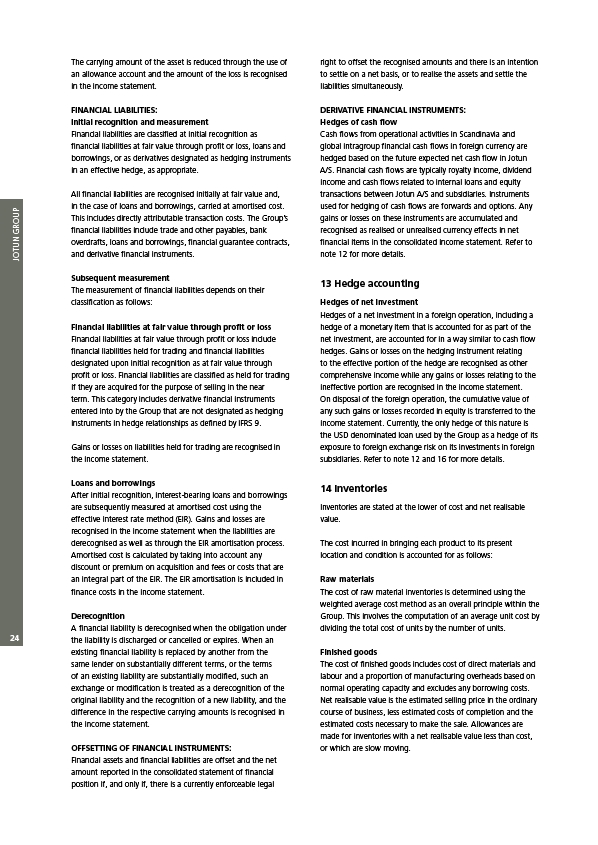
JOTUN GROUP
24
The carrying amount of the asset is reduced through the use of
an allowance account and the amount of the loss is recognised
in the income statement.
FINANCIAL LIABILITIES:
Initial recognition and measurement
Financial liabilities are classified at initial recognition as
financial liabilities at fair value through profit or loss, loans and
borrowings, or as derivatives designated as hedging instruments
in an effective hedge, as appropriate.
All financial liabilities are recognised initially at fair value and,
in the case of loans and borrowings, carried at amortised cost.
This includes directly attributable transaction costs. The Group’s
financial liabilities include trade and other payables, bank
overdrafts, loans and borrowings, financial guarantee contracts,
and derivative financial instruments.
Subsequent measurement
The measurement of financial liabilities depends on their
classification as follows:
Financial liabilities at fair value through profit or loss
Financial liabilities at fair value through profit or loss include
financial liabilities held for trading and financial liabilities
designated upon initial recognition as at fair value through
profit or loss. Financial liabilities are classified as held for trading
if they are acquired for the purpose of selling in the near
term. This category includes derivative financial instruments
entered into by the Group that are not designated as hedging
instruments in hedge relationships as defined by IFRS 9.
Gains or losses on liabilities held for trading are recognised in
the income statement.
Loans and borrowings
After initial recognition, interest-bearing loans and borrowings
are subsequently measured at amortised cost using the
effective interest rate method (EIR). Gains and losses are
recognised in the income statement when the liabilities are
derecognised as well as through the EIR amortisation process.
Amortised cost is calculated by taking into account any
discount or premium on acquisition and fees or costs that are
an integral part of the EIR. The EIR amortisation is included in
finance costs in the income statement.
Derecognition
A financial liability is derecognised when the obligation under
the liability is discharged or cancelled or expires. When an
existing financial liability is replaced by another from the
same lender on substantially different terms, or the terms
of an existing liability are substantially modified, such an
exchange or modification is treated as a derecognition of the
original liability and the recognition of a new liability, and the
difference in the respective carrying amounts is recognised in
the income statement.
OFFSETTING OF FINANCIAL INSTRUMENTS:
Financial assets and financial liabilities are offset and the net
amount reported in the consolidated statement of financial
position if, and only if, there is a currently enforceable legal
right to offset the recognised amounts and there is an intention
to settle on a net basis, or to realise the assets and settle the
liabilities simultaneously.
DERIVATIVE FINANCIAL INSTRUMENTS:
Hedges of cash flow
Cash flows from operational activities in Scandinavia and
global intragroup financial cash flows in foreign currency are
hedged based on the future expected net cash flow in Jotun
A/S. Financial cash flows are typically royalty income, dividend
income and cash flows related to internal loans and equity
transactions between Jotun A/S and subsidiaries. Instruments
used for hedging of cash flows are forwards and options. Any
gains or losses on these instruments are accumulated and
recognised as realised or unrealised currency effects in net
financial items in the consolidated income statement. Refer to
note 12 for more details.
13 Hedge accounting
Hedges of net investment
Hedges of a net investment in a foreign operation, including a
hedge of a monetary item that is accounted for as part of the
net investment, are accounted for in a way similar to cash flow
hedges. Gains or losses on the hedging instrument relating
to the effective portion of the hedge are recognised as other
comprehensive income while any gains or losses relating to the
ineffective portion are recognised in the income statement.
On disposal of the foreign operation, the cumulative value of
any such gains or losses recorded in equity is transferred to the
income statement. Currently, the only hedge of this nature is
the USD denominated loan used by the Group as a hedge of its
exposure to foreign exchange risk on its investments in foreign
subsidiaries. Refer to note 12 and 16 for more details.
14 Inventories
Inventories are stated at the lower of cost and net realisable
value.
The cost incurred in bringing each product to its present
location and condition is accounted for as follows:
Raw materials
The cost of raw material inventories is determined using the
weighted average cost method as an overall principle within the
Group. This involves the computation of an average unit cost by
dividing the total cost of units by the number of units.
Finished goods
The cost of finished goods includes cost of direct materials and
labour and a proportion of manufacturing overheads based on
normal operating capacity and excludes any borrowing costs.
Net realisable value is the estimated selling price in the ordinary
course of business, less estimated costs of completion and the
estimated costs necessary to make the sale. Allowances are
made for inventories with a net realisable value less than cost,
or which are slow moving.